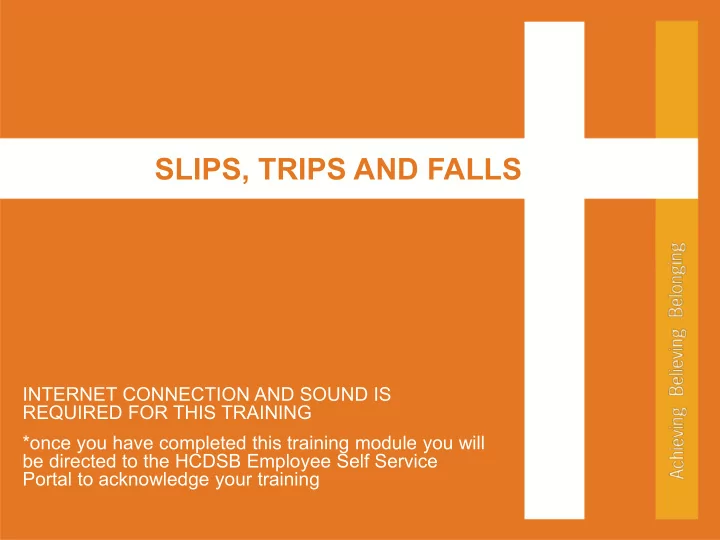

SLIPS, TRIPS AND FALLS INTERNET CONNECTION AND SOUND IS REQUIRED FOR THIS TRAINING *once you have completed this training module you will be directed to the HCDSB Employee Self Service Portal to acknowledge your training
Slips Trips and Falls Slips, trips and falls, whether on or off the job are expensive, disruptive, painful, and may even be tragic
Why Do We Slip? We slip when there is too little traction or friction between the foot and the walking surface surface
Causes of Slips Slip hazards exist when: Slip resistance depends on the things like: • not enough friction between your feet and the • walking surface, walking surface, and • soles of your shoes, and • you lose your balance • presence of foreign • technically the coefficient materials between walking of friction and its “Slip surface and your footwear Resistance Factor” is not high enough
Why Do We Trip? Change in the elevation of the walking surface (e.g. buckled carpet) Unseen object in path of travel (e.g. box on floor, cord on walkway)
Why Do We Fall? We fall when our center of mass moves outside the area of support and we cannot shift it back Usually, when there is an unexpected change in the walking surface
There are many factors to consider:
Types of Injuries from Slips Trips and Falls: • Broken bones • Concussions • Muscle tear • Bruises
Most Slip, Trip and Fall injuries can be prevented: #1 by eliminating workplace hazards and #2 by people taking proper action to work safely.
VIDEO SLIPS TRIPS AND FALLS - SCHOOL CLASSROOM
Preventing Slips Trips and Falls in the Classroom: • Wear appropriate footwear for the task • Maintain good housekeeping - ensure walkways are clear of hazards (cords, boxes, backpacks, liquids etc.) • Report hazards to your supervisor immediately • Keep items within reach or use CSA approved stepladders - never stand What are some other ways you can prevent slips, trips and falls in your on desk or chairs classroom?
Student chairs are not built for adults, we have had many serious injuries involving adults sitting/standing on student chairs. CSA approved ladders must be available.
FALLS from LADDERS Safe ladder use includes . . . • Proper Ladder SELECTION (CSA – Type 1) • Pre-Use and Post-Use INSPECTION • Proper Ladder SET-UP • Safe CLIMBING Technique • Safety while WORKING on a Ladder
* Employees working above 3m/10 feet must have Ministry of Labour approved training on Working at Heights
VIDEO SLIPS, TRIPS AND FALLS - SCHOOL STAIRS
Preventing Slips Trips and Falls on School Stairs: What are some ways you can prevent slips, trips and falls on the stairs?
Preventing Slips, Trips and Falls on Stairs: • Walk don’t run • Always use handrails • Wear appropriate footwear (low heal, rubber sole) • Take one step at a time • Ensure adequate lighting • Always keep stairs free of grease, oil and obstacles
VIDEO SLIPS TRIPS AND FALLS - SCHOOL CUSTODIAN
Behaviours that lead to Falls • Walking too fast or running • Changing direction too quickly • Not looking where we are going distracted • Carrying materials that obstruct our vision • Wearing sunglasses in low- light areas • Not using handrails
Summary - General Slip, Trip and Fall Prevention: • Be aware of changes in elevation and changes in walking surfaces (carpet to tile, wet to dry etc.) • When carrying things, make sure you can still see your path, get help or use a cart when carrying heavy or awkward objects • Remove or report unsafe conditions that could result in a slip/trip or fall such as spills, electric cords, frayed carpet etc. • Maintain outside walking areas free of ice, snow and woodchips • Anticipate slippery areas, don’t rush, plan ahead, make people aware (signs/announcements) • Keep aisles, halls, stairways and walkways clear of slip trip and fall hazards • Never stand on desk, chairs or any other unstable items to reach something – all schools have stepladders.
When choosing appropriate footwear consider the following: • Consider type of activity and protection required (ie- winter boots for outdoor duties/activities, steel toe if there is a risk of injury to toes) • Snug fit with enclosed toe/heal • Flat shoes or shoes with a minimal heel • No skid or slip resistant sole Inappropriate footwear: • Flip flops or beach shoes • Slippers • Plastic/gummy shoes • Shoes with spiked heels or platforms greater than 1 inch
Questions? Kimberly George Health and Safety Officer georgek@hcdsb.org 905-632-6300 Ext. 174
Recommend
More recommend